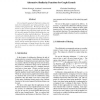Free Online Productivity Tools
i2Speak
i2Symbol
i2OCR
iTex2Img
iWeb2Print
iWeb2Shot
i2Type
iPdf2Split
iPdf2Merge
i2Bopomofo
i2Arabic
i2Style
i2Image
i2PDF
iLatex2Rtf
Sci2ools
ICPR
2008
IEEE
2008
IEEE
Alternative similarity functions for graph kernels
Given a bipartite graph of collaborative ratings, the task of recommendation and rating prediction can be modeled with graph kernels. We interpret these graph kernels as the inverted squared Euclidean distance in a space defined by the underlying graph and show that this inverted squared Euclidean similarity function can be replaced by other similarity functions. We evaluate several such similarity functions in the context of collaborative item recommendation and rating prediction, using the exponential diffusion kernel, the von Neumann kernel, and the random forest kernel as a basis. We find that the performance of graph kernels for these tasks can be increased by using these alternative similarity functions.
| Added | 30 May 2010 |
| Updated | 30 May 2010 |
| Type | Conference |
| Year | 2008 |
| Where | ICPR |
| Authors | Jérôme Kunegis, Andreas Lommatzsch, Christian Bauckhage |
Comments (0)

